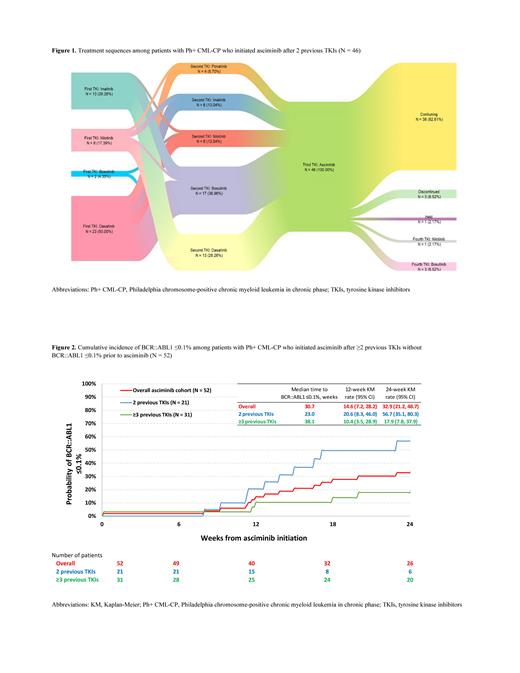Introduction: Tyrosine kinase inhibitors (TKIs) are the mainstay of treatment for CML-CP. Asciminib, a first-in-class inhibitor to Specifically Target the ABL Myristoyl Pocket (STAMP), was FDA-approved on 10/29/2021 for the treatment of adult patients with Philadelphia chromosome-positive (Ph+) CML-CP, previously treated with two or more TKIs or Ph+ CML-CP with the T315I mutation. This study described treatment patterns and real-world clinical outcomes of asciminib in the US.
Methods: Data through 11/30/2022 from adult patients with Ph+ CML-CP who initiated asciminib were obtained from the Flatiron Health oncology electronic health record (EHR)-derived de-identified database. Patients who initiated asciminib after ≥2 previous TKIs, without a stem-cell transplant prior to asciminib, and without the T315I mutation, were included in the overall cohort. Time-to-treatment discontinuation and molecular response (MR; time-to-BCR::ABL1 ≤0.1% and time-to-BCR::ABL1 ≤1%, separately) were evaluated from asciminib initiation (index date) using Kaplan-Meier analyses overall, and by the number of TKIs used pre-index (2 previous TKIs, and ≥3 previous TKIs). Patients were required to have ≥1 MR test post-index to be included in the MR assessment; a sensitivity analysis was conducted excluding patients with BCR::ABL1 ≤0.1% or better (≤1% or better) for time-to-BCR::ABL1 ≤0.1% (time-to-BCR:ABL1 ≤1%), as evaluated in the ASCEMBL trial.
Results: Overall,97 patients with Ph+ CML-CP initiated asciminib (median age: 63 years, 50.5% female, 64.9% White, 84.8% ECOG 0-1, 61.9% from community-based practices, median follow-up of 6 months post-index). Other malignancies (19.6%), chronic pulmonary disease (18.6%), renal disease (18.6%), and congestive heart failure (16.5%) were the most prevalent pre-index comorbidities. The distribution of last MR in the 3 months pre-index was: 24.7% BCR::ABL1 >10%, 18.6% BCR::ABL1 ≤10% and >1%, 12.4% BCR::ABL1 ≤1% and >0.1%, 12.4% BCR::ABL1 ≤0.1% and >0.01%, and 8.2% BCR::ABL1 ≤0.01% (23.7% not tested/documented).
Forty-six patients (47.4%) initiated asciminib after 2 previous TKIs, 24 (24.7%) after 3 TKIs, and the remainder after ≥4 previous TKIs (27.8%). Most patients (78.4%) were prescribed 80 mg (40.2% once daily, 38.1% 40 mg twice a day) at treatment initiation. Use of TKIs prior to asciminib included dasatinib (85.6%), imatinib (63.9%), bosutinib (61.9%), nilotinib (53.6%), and ponatinib (15.5%). Treatment sequences among patients who initiated asciminib after 2 previous TKIs (n=46) are presented in Figure 1. Overall (n=97), persistence rates were 85.7% by 12-weeks (2 previous TKIs: 89.8%; ≥3 previous TKIs: 82.5%) and 78.1% by 24-weeks (2 previous TKIs: 81.8%; ≥3 previous TKIs: 75.3%) post-index.
Among patients with ≥1 MR test post-index (n=70), 31.3% (2 previous TKIs: 43.3%; ≥3 previous TKIs: 21.6%) and 49.7% (2 previous TKIs: 71.5%; ≥3 previous TKIs: 33.4%) achieved or maintained BCR::ABL1 ≤0.1% by 12- and 24-weeks, respectively. In addition, 51.3% (2 previous TKIs: 68.7%; ≥3 previous TKIs: 37.2%) and 64.2% (2 previous TKIs: 79.7%; ≥3 previous TKIs: 51.4%) achieved or maintained BCR::ABL1 ≤1% by 12- and 24-weeks, respectively.
For patients without BCR::ABL1 ≤0.1% prior to asciminib (n=52; Figure 2), 14.6% (2 previous TKIs: 20.6%; ≥3 previous TKIs: 10.4%) and 32.9% (2 previous TKIs: 56.7%; ≥3 previous TKIs: 17.9%) achieved BCR::ABL1 ≤0.1% by 12- and 24-weeks, respectively, with a median time of 30.7 weeks (2 previous TKIs: 23.0 weeks; ≥3 previous TKIs: 38.1 weeks). For patients without BCR::ABL1 ≤1% prior to asciminib (n=43), 35.6% (2 previous TKIs: 61.9%; ≥3 previous TKIs: 21.9%) and 46.3% (2 previous TKIs: 61.9%; ≥3 previous TKIs: 37.2%) achieved BCR::ABL1 ≤1% by 12- and 24-weeks, respectively, with a median time of 24.6 weeks (2 previous TKIs: 11.3 weeks; ≥3 previous TKIs: 26.9 weeks).
Conclusion: This is the first real-world study describing treatment patterns and clinical outcomes among patients with Ph+ CML-CP treated with asciminib in the US. The findings of real-world treatment efficacy based on achieving BCR::ABL1 ≤0.1% were consistent with the ASCEMBL trial. Patients who initiated asciminib after 2 previous TKIs had higher persistence and treatment response rates than those initiated on asciminib after ≥3 previous TKIs. Further studies are warranted to continuously demonstrate the effectiveness of asciminib in a real-world setting.
Disclosures
Atallah:Abbvie: Consultancy, Research Funding, Speakers Bureau; BMS: Consultancy, Speakers Bureau; Novartis: Consultancy, Research Funding; Takeda: Consultancy, Research Funding. Wei:Novartis: Current Employment, Current equity holder in publicly-traded company. Latremouille-Viau:Bristol Myers Squibb: Consultancy, Research Funding; Novartis Pharmaceuticals Corporation: Consultancy, Other: I am an employee of Analysis Group, Inc. a consulting company which received funding from Novartis.; Pfizer Inc.: Consultancy, Research Funding; Analysis Group, Inc.: Current Employment, Other: I am an employee of Analysis Group, Inc. a consulting company which received funding from Novartis.. Rossi:Janssen Scientific Affairs, LLC: Consultancy; Analysis Group: Current Employment, Other: Analysis Group, Inc. has received consultancy fees from AbbVie; Novartis Pharmaceuticals Corporation: Consultancy, Other: I am an employee of Analysis Group, Inc. a consulting company which received funding from Novartis.. Damon:Novartis: Current Employment, Current equity holder in private company. Ferreira:Novartis Pharmaceuticals Corporation: Consultancy, Current Employment. Guerin:Novartis Pharmaceuticals Corporation: Consultancy, Other: I am an employee of Analysis Group, Inc. a consulting company which received funding from Novartis.; Analysis Group, Inc.: Current Employment, Other: Analysis Group, Inc. has received consultancy fees from AbbVie. Jadhav:Novartis: Current Employment, Current equity holder in publicly-traded company, Current holder of stock options in a privately-held company.


This feature is available to Subscribers Only
Sign In or Create an Account Close Modal